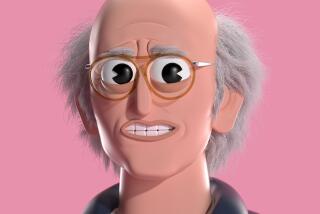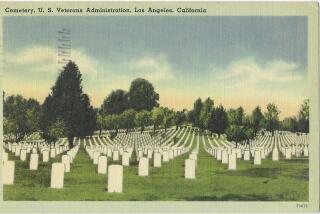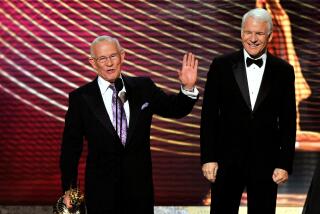Fans Get Within Six Feet of Their Favorite Stooge
- Share via
The young fan in the wheelchair had come all the way from Florida for this brief moment with a bygone Hollywood hero.
Like others, he brought flowers last year to the Jewish cemetery in Boyle Heights where so many entertainment legends are buried.
But as his mother guided the family van along palm-shaded lanes, the boy didn’t blink at the grave sites of studio founder Jack Warner, film producer Louis B. Mayer or even singer-comedian Fanny Brice.
He had come for Curly and Shemp.
The Howard brothers, those two masters of mayhem, who teamed with brother Moe and red-headed Larry Fine to help redefine three decades of American humor as the legendary Three Stooges, the sultans of slapstick.
The boy’s mother wheeled him to Curly’s grave and left him alone. Sitting in silence, he must have thought about the times mean-spirited Moe had steam-pressed Curly’s head, poked him in the eyes or jolted him with a hammer, saying, “Why yooouuuu . . . I’ll moida ya!”
He could have imagined childlike Curly patting his head and rubbing his belly at Moe in mock defiance, doing his infamous shoulder spins and drunken-Fred Astaire-on-drugs dance routines. Woo-woo-woo. Nyuk-nyuk-nyuk.
Soitenly he did.
“Those Curly antics had apparently gotten him through some tough times,” said Tom Tuvim, manager of the Home of Peace Memorial Park and Mausoleum. “The kid stayed there 90 minutes just meditating. Graveyard or not, he was with Curly for that time.”
For most tourists, it’s a road less taken on the Hollywood circuit, the detour to the East L.A. cemetery. But for Stooge fans worldwide, no pilgrimage to Movieland would be complete without first paying their respects to The Boys.
The loyal ones come with their Stooge-Mania T-shirts, scrapbooks and Stooge paraphernalia. They arrive atop Harley-Davidsons and inside mobile homes, as solitary singles or groups of half a dozen, hailing from Tokyo to Timbuktu.
They find Curly nestled in Row 5 of a far-flung corner of the 30-acre cemetery, the gravestone carrying his real first name. “Beloved husband, father and brother,” it reads. “Jerome Howard. Oct. 22, 1903--Jan. 18, 1952.”
Shemp isn’t far away. Just walk past Fanny Brice’s cremated remains in the cavernous Art Deco mausoleum and you’ll find him down the Corridor of Eternal Life. On his crypt sit three pebbles, a sign that the faithful have come and gone.
Stooge Maniacs.
“Forget Universal Studios. When my friends come to town, the first place we do is commune with Curly, Shemp, Moe and Larry,” says Greg Smith, a local tour operator. “It’s a trip to be within six feet of your favorite Stooge. There’s no way to describe it.”
Moe Howard is buried at Hillside Memorial Park and Mortuary near Culver City. And trio middleman Larry Fine can be found at Forest Lawn Cemetery in Glendale. While their grave sites still attract visitors, the numbers are relatively few compared to other stars.
But over at Home of Peace, Curly and Shemp still draw them like the old days.
Especially Curly.
“No doubt, he’s by far the most popular person buried here,” says Tuvim, a 68-year-old caretaker with Bela Lugosi eyebrows. “They come from Japan looking for him. Recently, we had people show up from Africa.”
Such demand doesn’t surprise Gary Lassin, president of the 2,000-member Three Stooges fan club, based in Philadelphia: “When we take polls of our members, Curly gets more votes than all the other Stooges combined.”
Strangely, one of Curly’s biggest fans is Moe’s daughter, Joan Howard Maurer, who even wrote a book about him, “Curly: A Biography of the Superstooge.”
“Like me, I think his fans can see how vulnerable he was,” she says. “Curly just wanted to live life. He loved women. He liked to drink. He ate too much. He did everything that was bad for him. He was this big kid on-screen and in real life as well. My dad was his dad. He followed him around, worrying about him.”
That is, when he wasn’t uttering on-screen Moe-isms such as “I’ll knock your teeth out!” or “I’ll make powder out of you!” or “Mingle or I’ll mangle!’
The Stooges made their debut in 1922 when vaudevillian Ted Healy first featured his boyhood pal, Moe, as his “stooge” and straight man. Shemp soon joined the act, followed in 1925 by violinist Larry Fine.
After a move to Depression-era Hollywood, Shemp was replaced by kid brother Curly--who reluctantly shaved his wavy brown hair for the role. Soon, movie audiences roared at the trio’s eye-poking, face-slapping, hair-pulling brand of screen anarchy.
In 1946, Curly suffered a stroke. Partially paralyzed, he died six years later at age 48. Shemp, who then replaced Curly, died in 1955, and the third Stooge role was taken over by Joe Besser and later by Joe DeRita.
Both Moe and Larry died in 1975.
Together, the Stooges made 200 short-subject and full-length films, and earned a star on the Walk of Fame. They’ve had a retrospective at the Kennedy Center. And they’ve been credited with such cultural influences as Michael Jackson’s moon walk, Beatle John Lennon’s mop haircut and actor John Belushi’s irreverent on-screen persona.
Curly’s antics even inspired writers such as Jack Kerouac, who, in his 1959 novel “Visions of Cody,” took a playful swipe at the comedian: “All big dumb convict Curly does is muckle and yukkle and squeal, pressing his lips, shaking his old butt like jelly, knotting his Jell-O fists, eyeing Moe, who looks back at him with that lowered and surly, ‘Well what are you gonna do about it?’ ”
When the latest Stooge Mania hit a decade ago, the number of visitors increased at Home of Peace. Young families. Old women with canes.
So, while they discourage grave searches, staffers try to accommodate them. Especially the Harley-Davidson riders.
“When they rumbled in here, it scared the daylights out of me,” Tuvim recalls. “So I just pointed the way.”
Stooge grave-site visits are strangely solemn affairs--no busloads of raucous fans belting out Curly-calls. Most imagine favorite Stooge scenes, such as Curly backing into a cactus or the time The Boys unearthed King Rootentooten’s tomb and Curly got wrapped up like a mummy, says frequent visitor Smith.
“It’s funny to be there, not sad,” he says. “None of us ever knew the real Curly. So this is our chance for some intimacy with a comedian who has surpassed cult. People just can’t seem to get enough of him.”
Cemetery worker Aurelio Munoz says he often sees frustrated fans searching for The Stooges.
So he shows them.
“These Stooges have been here a long time,” say Munoz, shoveling dirt from a fresh grave.
“They need the company.”
More to Read
The biggest entertainment stories
Get our big stories about Hollywood, film, television, music, arts, culture and more right in your inbox as soon as they publish.
You may occasionally receive promotional content from the Los Angeles Times.











